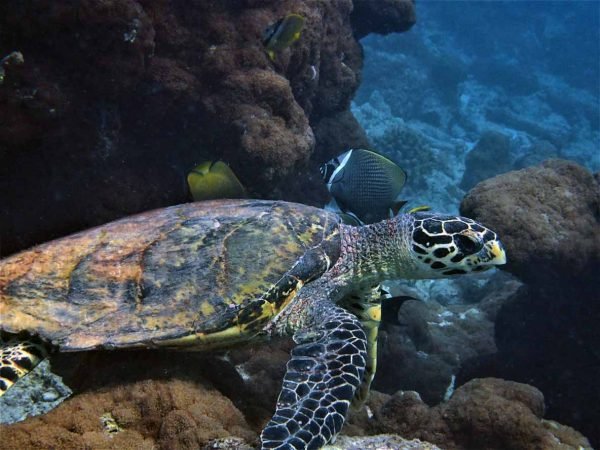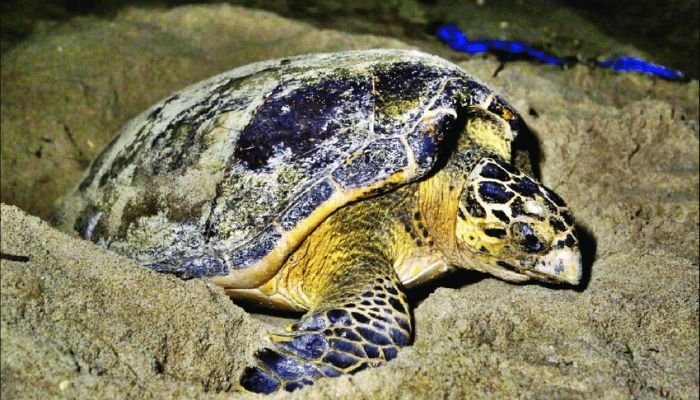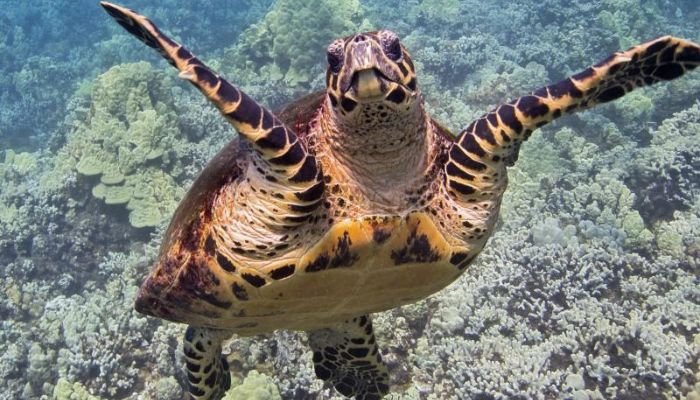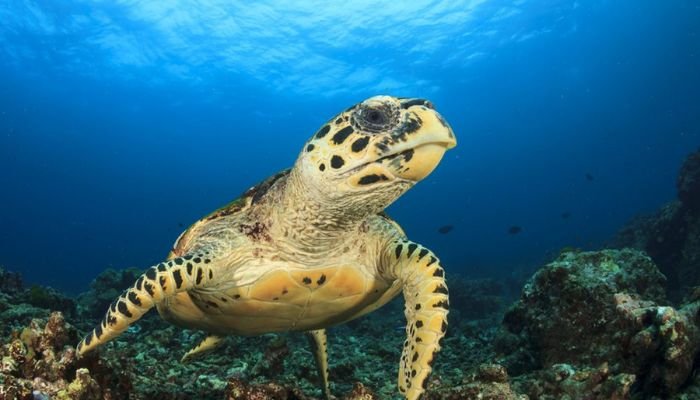
The Hawksbill Turtle is an exceedingly rare species of sea turtle that is valued for its contribution to marine ecosystems. Its name was derived from its short, beak-like mandible, which enables it to consume sponges, which are abundant in coral reef habitats. Hawksbill turtles serve a vital role in maintaining the health of coral reefs by controlling sponge populations. Unfortunately, these reptiles face numerous threats, including habitat loss, exploitation, and climate change. To preserve these incredible species and their habitats, conservation measures are necessary.. Here are Hawksbill turtle Guide on Food, Habitat, Size, Lifespan & Predators below-
Hawksbill Turtle Stats in Table format
The stats are given below for Hawksbill turtle
| Reptiles List | Hawksbill turtle |
|---|---|
| Family | Cheloniidae |
| Type | Turtle |
| Size | Medium to Large |
| Length | Hawksbill turtle: Up to 2-3 feet (0.6-0.9 meters) |
| Color | Hawksbill turtle: The color varies depending on the age and location, but hawksbill turtles can have shades of brown, orange, or black with lighter markings. |
| Weight | Hawksbill turtle: Adult hawksbill turtles can weigh between 100 to 150 pounds.. |
| Lifespan | 30-50 years (or more) |
| Reproduction | Oviparous, lays eggs |
| Gestation Periods | The gestation period for Hawksbill turtles is approximately 60-75 days. |
| Endangered Status | Critically Endangered (IUCN Red List) |
| Features | Distinctive pattern on the shell, sharp beak-like mouth |
| Country & Areas | Found in tropical and subtropical waters of the Atlantic, Pacific, and Indian Oceans, including the Caribbean and Great Barrier Reef. |
Hawksbill Turtle Natural Habitat and Distribution
The Hawksbill turtle lives in the warm and warm-temperate waters of the world’s oceans. Being found in all three major oceans, this species is among the most extensively dispersed sea turtles. Coral reefs, rocky shores, and shallow coastal waters are common places to find these reptiles. Sponges make up the bulk of their diet, hence they gravitate toward sandy beaches in locations rich in this food supply.
Hawksbill Turtle Physical Features and Adaptations
Here are some information on Hawksbill Turtle Physical Features and Adaptations:-
Body Structure:
The Hawksbill turtle is easily distinguished from other species of sea turtles due to its unusually shaped body. Their overlapping scutes, or keratinous plates, are a stunning array of amber, brown, and black colors, and their carapace (top shell) is fashioned like a heart. Their small, beak-like heads are excellently designed for extracting prey from tight spaces in coral reefs. Their forelimbs have been transformed into flippers, further enhancing their agility in the water.
Coloration and Patterns:
The complex coloring and patterning on a Hawksbill turtle’s carapace serve as camouflage in the wild. Their one-of-a-kind appearance allows them to disappear into the vivacious colors of coral reefs, where they have a better chance of ambushing their prey without being spotted.
Defense Mechanisms:
Hawksbill turtles can protect their vulnerable heads by pulling them into their shells during a fight. However, the narrowness of their heads makes them less capable of total withdrawal than other turtle species. Therefore, they have to rely on their swiftness and pointed beaks to protect themselves from damage and avoid being eaten.

Hawksbill Turtle Diet and Feeding Habits
Here are some information on Hawksbill Turtle Diet and Feeding Habits:-
Diet Type:
The diet of a hawksbill turtle consists mostly of both plant and animal materials. Their diet is distinct, with a heavy emphasis on sponges that are important to the health of coral reefs.
Preferred Food Sources:
The diet of the Hawksbill turtle consists primarily of sponges. Their jaws are adapted for reaching into cracks and scraping sponges from the reef’s top. They might also eat other invertebrates that live in coral reefs, such as algae, jellyfish, sea anemones, and sponges.
Feeding Schedule:
Hawksbill turtles are primarily diurnal, or active throughout the day. They spend most of the day searching for food and then retiring to their dens at night.
Hawksbill Turtle Housing and Enclosure Requirements
Here are some information on Hawksbill Turtle Housing and Enclosure Requirements:-
Terrarium Size and Setup
Hawksbill turtles, as sea species, need a large, specially designed enclosure to simulate their natural habitat in the wild. Having a large indoor aquarium with plenty of room to swim and rest is crucial for animals kept in captivity. Semi-open cages that provide access to land and water are ideal for larger facilities.
Substrate Options:
A Hawksbill turtle’s enclosure should have a substrate that is similar to the sandy or rocky ground they would find in the wild. They can use fine sand or a combination of sand and gravel for nesting if necessary.
Temperature and Lighting:
The survival of these turtles depends on keeping the water at the ideal temperature. The ideal temperature for the water is between 75 and 85 degrees F (24 and 29 degrees C), while the ideal temperature for the basking area is approximately 90 degrees F (32 degrees C). Vitamin D3 production and calcium metabolism are both greatly aided by adequate exposure to UVB radiation.
Humidity and Water Needs:
As marine reptiles, hawksbills need access to saltwater that has been properly filtered. The enclosure should provide both a shallow and deep region to help the turtle maintain a comfortable internal temperature. To avoid breathing problems, a well-ventilated enclosure is preferable but not required.
Hawksbill Turtle Behaviour and Temperament
Here are some information on Hawksbill Turtle Behaviour and Temperament:-
Activity Levels:
During the day, hawksbill turtles are frequently seen swimming around, hunting for food and investigating their surroundings. They spend the night on the ocean floor or wherever they can find a safe haven within their habitat.

Social Behaviour:
Hawksbill turtles are solitary animals that rarely interact with one another. However, arribadas can occur when female turtles congregate on beaches to lay their eggs.
Handling and Taming:
Hawksbill turtles are sensitive and shouldn’t be handled, especially in the wild. In confinement, the turtle and the caretaker should have as little contact as possible to minimize stress and the risk of harm.
Hawksbill Turtle Mating and Courtship Rituals:
Here are some information on Hawksbill Turtle:-
Mating and Courtship Rituals:
Between the ages of 20 and 40, hawksbill turtles are considered to have reached sexual maturity. Male turtles will battle it out for the attention of a female during the mating season. Swimming displays and flirtatious touches are common courtship tactics.
Incubation and Hatchlings:
During the nesting season, female Hawksbill turtles will deposit their eggs on sandy beaches after giving birth. After a few months, the eggs will hatch, and the young will swim toward the ocean. However, light pollution regulation is vital in protecting their numbers since artificial illumination near nesting locations can disorient the hatchlings, leading them away from the water.
Hawksbill Turtle Common Health Issues and Veterinary Care
Here are some information on Hawksbill Turtle Common Health Issues and Veterinary Care:-
Respiratory Infections:
Captive Hawksbill turtles frequently suffer from respiratory illnesses due to inadequate housing or care. Sneezing, runny nose, and fatigue are some of the symptoms. A timely diagnosis and treatment of respiratory diseases is greatly aided by routine veterinarian examinations.
Parasites:
The health of Hawksbill turtles, both in the wild and in captivity, can be negatively impacted by parasites. Regular veterinary inspection of feces is necessary for the diagnosis and treatment of parasite diseases.
Metabolic Bone Disease:
Bone weakness and abnormalities are symptoms of metabolic bone disease, a nutritional illness caused by insufficient calcium and vitamin D3. Preventing this illness requires a combination of a healthy diet and plenty of light.

Importance of Regular Vet Check-ups
The health of Hawksbill turtles, whether they are living in captivity or the wild, relies heavily on routine veterinary examinations. Veterinarians with experience may identify health problems early, provide medicines, and advise owners on how to best care for their animals in terms of diet and housing.
Conclusion
Amazing and instantly recognizable, the Hawksbill turtle plays a crucial role in keeping marine ecosystems healthy. Many people all over the world who are interested in marine life are captivated by clownfish because of their distinctive appearance, unusual food, and important function in maintaining coral reefs. We can better appreciate and safeguard these amazing species for future generations if we learn more about their native environment, dietary demands, and behavioral habits. The fate of the Hawksbill turtle and other marine species depends on us maintaining the delicate balance of our seas through responsible pet ownership and conservation activities.
FAQs
Q: What is the family and Type of a Hawksbill turtle?
A: The Hawksbill turtle is a species of the family Cheloniidae. The Famous Hawksbill turtle is a member of the family Turtle.
Q: What is the average size of a Hawksbill turtle?
A: The average adult Hawksbill turtle is Medium to Large between Hawksbill turtle: Up to 2-3 feet (0.6-0.9 meters).
Q: How long can a Hawksbill turtle grow in size in length?
A: Hawksbill turtle is Medium to Large in size and The Hawksbill turtle can grow up to 2-3 feet (0.6-0.9 meters) in length.
Q: What colors do Hawksbill turtle come in?
A: The color of hawksbill turtles can vary depending on their age and where they are found. These beautiful creatures can display shades of brown, orange, or black, often adorned with lighter markings..
Q: How big can a Hawksbill turtle get in weight?
A: The weight of adult hawksbill turtles can range from 100 to 150 pounds.
Q: What are the special Features of a Hawksbill turtle?
A: Hawksbill turtle is Distinctive patterns on the shell, a sharp beak-like mouth
Q: How long do Hawksbill turtles live?
A: The usual lifespan of a Hawksbill turtle is The Hawksbill turtle has an average lifespan of 30-50 years, although some individuals can live even longer.
Q: What food does the Hawksbill turtle eat?
A: The hawksbill turtle primarily feeds on sponges, but also consumes other marine invertebrates such as jellyfish, sea anemones, and shrimp. They have a specialized beak that allows them to reach into crevices and extract their food. Hawksbill turtles are also known to eat algae and seagrass, especially when they are young.
Q: What is the best habitat for a Hawksbill turtle?
Hawksbill turtles thrive in the warm, shallow waters of coral reefs along the shore. These turtles live in the tropics and subtropics, where the coral reefs provide them with food and protection. They get the invertebrate and plant matter they need to survive from the reefs. Nesting hawksbill turtles need sandy beaches just like other turtle species. They can only maintain their body temperature and locate ideal mating grounds in the warm, clear waters of coastal areas. Unfortunately, the Hawksbill turtle population is in serious jeopardy as a result of habitat destruction, pollution, and climate change, all of which are reducing the availability of these habitats. Protecting and restoring their habitats is essential to ensuring these species’ existence.
Q: How do Hawksbill turtles give birth?
A: Hawksbill turtle are Oviparous, and lays eggs
Q: How long is the gestation period for a Hawksbill turtle?
A: The gestation period of a Hawksbill turtle is approximately The gestation period for Hawksbill turtles is approximately 60-75 days.
Q: What is the natural behavior of a Hawksbill turtle?
The majority of Hawksbill turtles are found in The hawksbill turtle engages in a wide range of behaviors in its natural environment. Sponge, jellyfish, and other invertebrate foods make up the majority of their diet, and they spend much of their time in tropical and subtropical seas. They’re well-known for their long-distance navigation skills, which they use on their migrations between feeding and nesting areas. Female hawksbill turtles are also notable because they typically nest on the very same beach on where they were born. They make a nest in the sand, deposit their eggs (usually around 100 of them), and then cover the nest and head back out to sea. The primary activities of a wild Hawksbill turtle are feeding, migrating, and nesting.
Q: Is the Hawksbill turtle endangered?
A: The Hawksbill turtle is Critically Endangered (IUCN Red List).
Q: What are the prey of Hawksbill turtle?
A: The prey of Hawksbill turtles include sponges, jellyfish, sea anemones, mollusks, crustaceans, and small fish. They primarily feed on coral reefs and rocky areas, using their sharp beak-like mouth to tear apart their prey. Hawksbill turtles are known for their specialized diet, as they have a unique ability to consume toxic sponges without being affected by the toxins. This makes them an important species in maintaining the health and balance of coral reef ecosystems..
Q: Do Hawksbill turtles have any Predators?
Turtles with hawksbills have Sharks, huge fish like groupers and barracudas, and octopuses are among the predators of hawksbill turtles. Humans, who are interested in their shells, meat, and eggs, are also predators. In addition, crabs, raccoons, and other animals frequently feast on their eggs.
Q: How Fast Does Hawksbill turtle Move?
A: Hawksbill turtles can swim at speeds of up to 20 miles per hour.
Q. What is Bite Force of Hawksbill turtle in PSI?
A. Bite Force in PSI of a hawksbill turtle is not available as they do not have strong biting capabilities.
Q: Can we keep Hawksbill turtles as pets?
The hawksbill turtle is not a candidate for pet ownership, unfortunately. They are not domesticated and hence need special conditions and food to survive. Due to their critically endangered condition, they also enjoy legal protection on a global scale. Keeping them as pets is against the law, and protecting their wild numbers is crucial.
Q. Are Hawksbill Sea Turtle venomous?
Hawksbill sea turtles, on the other hand, are not poisonous. Because they consume mostly plant matter, these reptiles lack venom and other poison delivery systems.
Q. Are Hawksbill Sea Turtle good for pest control?
Using Hawksbill Sea Turtles to get rid of unwanted pests is not an option. Most of their diet consists of sponges, algae, and other types of marine flora. While their diet contributes to a healthy marine ecosystem, they do not actively manage pest populations like some species on land do.
Q. Do Hawksbill Sea Turtle require a UVB light source?
